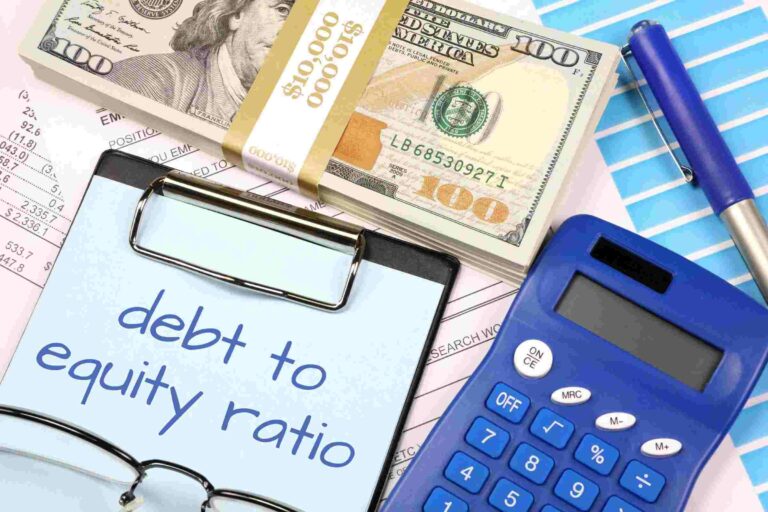Debt-to-equity ratio: meaning, importance, and more

What is debt-to-equity ratio?
Debt-to-equity (D/E) ratio is used to check a company’s financial leverage and is calculated by dividing a company’s total liabilities by its shareholder equity. D/E ratio is a useful metric in corporate finance. It helps to measure the degree to which a company is financing its operations with debt rather than its own resources. A company’s debt-to-equity ratio shows the relationship between equity and debt. It is calculated to measure a company’s solvency and to analyze how capital is distributed in a company. It is therefore a good measure of the financial leverage of a company.
Importance of calculating debt-to-equity ratio
The debt-to-equity ratio of a company is closely monitored by creditors and investors because it concretely shows the extent to which the company itself is responsible for the financing of all assets. Lenders, such as banks, are therefore extremely sensitive to this ratio because it is an indication of whether or not a loan is feasible and can be repaid.
It is considered an important metric because it indicates a company’s financial stability and its ability to grow and raise additional capital.
To further clarify what the ratio means, we first discuss what ‘Debt’ and ‘Equity’ mean.
What falls under debt (or debt)?
A company’s debt is the amount owed to meet loans from a bank or private lender. The lender agrees to take out a loan and the borrower agrees to repay this amount and the additional interest. A company acquires these debts in order to obtain sufficient resources needed to run the business efficiently.
What is equity?
Simply put, it involves all of a company’s assets. This can range from a car to machines or real estate. This is only taken into account as equity when the debts on that asset have been paid and it is therefore fully owned by the company.
How to calculate equity
The most common way to calculate the debt-to-equity ratio is to divide total debt by total equity.
The total number of debts is calculated by adding the long-term debts to the short-term debts and the current account.
Total equity is equal to the total assets, subtracted by all of a company’s liabilities.
Example calculation
Suppose a company currently has a debt of 50,000 euros and an equity of 100,000 euros. This means that the debt-to-equity ratio is 0.5. In concrete terms, this means that for every euro of equity, the company has 50 cents in debt.
Good vs bad debt-to-equity ratios
It is important to note that a debt-to-equity ratio can vary widely by industry. Some companies simply need more debt to scale than others. For example, a company that operates in the retail sector will carry more debt than a company that delivers all of its products and services online. The business in the retail sector has to consider warehouses, warehouses to process products, retail spaces, and so on. These extra ‘debts’ will therefore have an impact on the ratio between debt and equity.
A good or bad ratio is therefore completely relative. It is rather advisable to compare the debt-to-equity ratio per sector. Nevertheless, the following standards are generally used to determine whether a debt to equity is high or low:
If the ratio is lower than 0.25, we speak of a low debt-to-equity ratio
Between 0.25 and 0.5 we can assume an optimal ratio
Higher than 0.50, the ratio is (too) high
What to do if the debt-to-equity ratio is too high
- Reducing operating costs: A general reduction in operating costs can reduce the ratio. Think of processes that can be optimized, negotiations with suppliers, cheaper raw materials…
- Generating more profit: By generating more profit, more resources become available that can be used on the one hand to pay off existing debts, or on the other hand to invest in order to increase equity.
- Converting loans into shares: Certain loans can in some cases be converted into shares. Lenders then receive shares in the company and the debt disappears.
- Selling shares: Selling shares will increase the equity of the company. This income can then also be used to pay off debts.
As an entrepreneur, you need a clear picture of your figures and situation. However, this is not always self-evident, because such insight requires a lot of time and expertise. That is why you can rely on solutions to assist you in this. A virtual CFO, or finance controller for a day guides you to better manage your business.
Conclusion
The D/E ratio quantifies the degree to which a company has leveraged its assets net of liabilities with debt financing. Given the non-deferrable nature of interest payments and the potential for default-induced equity value destruction, the D/E ratio is a widely accepted proxy for investment risk, with higher ratios signaling a greater reliance on debt financing. When a company opts for debt-financed growth, it may potentially enhance its earnings.
However, the outcome for shareholders depends on whether the incremental profit rise surpasses the concomitant upsurge in debt service expenses. If the earnings growth exceeds the debt service costs, then investors can anticipate a positive outcome. Conversely, if the augmented expenses associated with debt financing outweigh the increased income, it can lead to a reduction in share prices. The company’s capacity to service its debt and the cost of borrowing can fluctuate depending on the prevailing market conditions.
Hence, the borrowing that may have seemed advantageous initially may turn out to be disadvantageous in the future due to changes. One of the key determinants of a company’s debt-to-equity (D/E) ratio is the fluctuation in its long-term debt and assets, owing to the considerable amounts involved relative to short-term debt and assets. However, to assess a company’s short-term solvency and its capacity to meet its financial commitments due within a year, investors can resort to alternative ratios.
Don't miss a thing. Follow us on Telegram and Follow us on WhatsApp. If you love videos then also Subscribe to our YouTube Channel. We are on Twitter as MakeMoneyDotNG.





